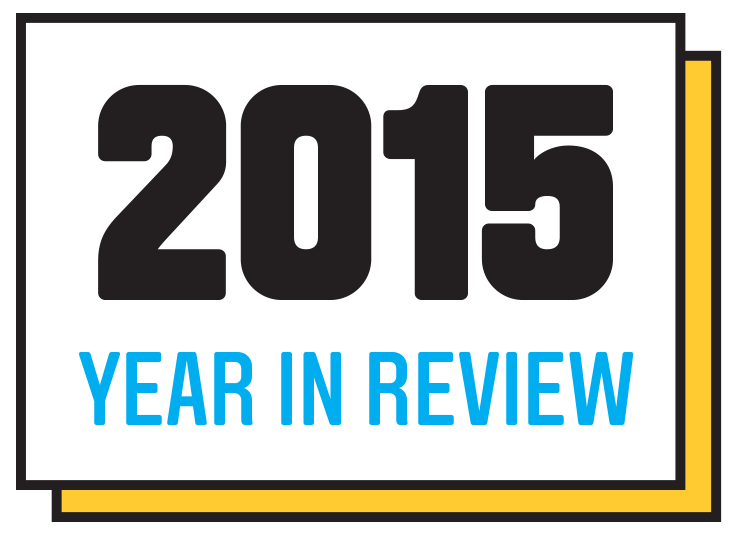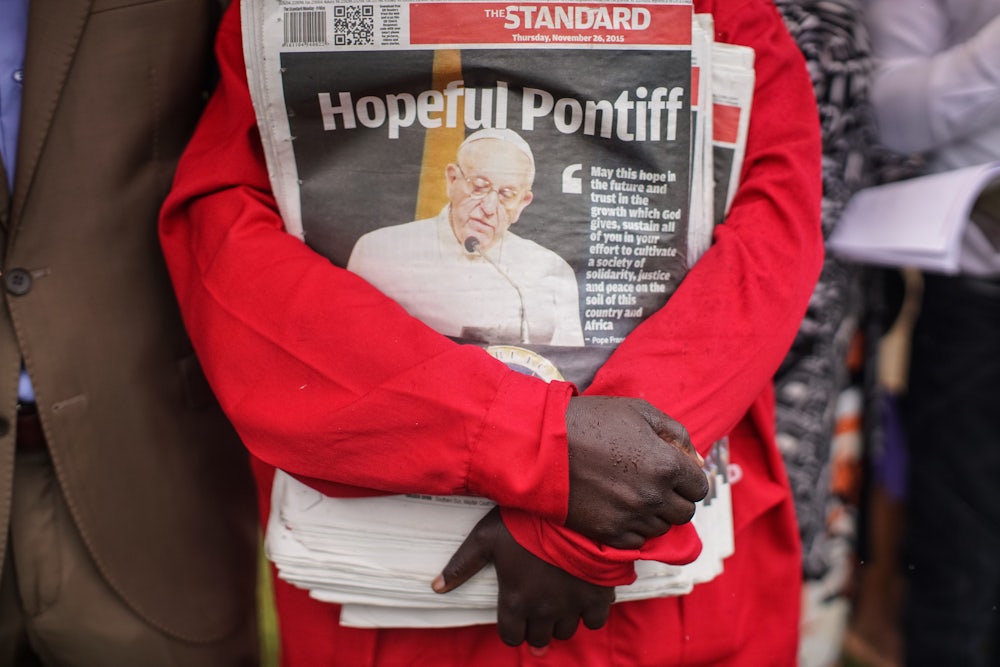
In America, the role of religion in politics is always grounds for op-eds and letters-to-editors, if not reams of articles and stacks upon stacks of books. This has especially been the case over the last several decades, thanks to the ascendancy of the Religious Right in the late 1970s and early 1980s. But the inverse concern—the place of politics in religion—also has its own hearty tradition of debate, unfolding sometimes in public but more often in the religious-specific publications of particular denominations.
In 2015, however, we saw the two genres intersect often in the pages of the country’s most-read publications, much thanks to the larger-than-life presence of Pope Francis. The result was an unusually public debate about the internal workings of the Catholic Church, its ethics and practices, and most crucially its future. But did all that argument—much of it fraught with old tensions—serve the Church or act as an unfortunate airing of dirty laundry? And how will the year’s headlines factor into the legacy of “the Francis effect,” that curious aura of influence hoped to bring the lapsed back to pews and the faithful to greater awareness of God?
While Francis’s unique persona may have sparked a year of particularly vibrant coverage of the Church, some important preconditions set the stage for strong, concerted religion coverage. Awareness of the role of religion in politics and society has risen over the last several years, due both to international conflicts involving religious extremism and to domestic arguments over religious liberty, leading several publications to expand their general religion coverage. The willingness of major publications to closely consider religious belief and practice has occasioned the birth of sites like Crux, which, since its launch in the fall of 2014, has served as The Boston Globe’s catch-all for coverage of Catholicism and Catholic-related issues. Crux and other religion verticals have acted as bridges between general, secular news coverage and media attention to the internal workings of religion, making the intense intra-Catholic debates of the last year possible.
It isn’t as though the Catholic Church has never made major media headlines before, of course: Readers of today’s Catholic-related news will undoubtedly recall the sex-abuse crisis and its attendant coverage. Residual media cynicism about the Church seems to have lingered up until 2013 and the papacy of Francis, which, little by little, restored some measure of moral credibility to the Church in the minds of the public at large. Francis’s personality—unpredictable, inspiring, sometimes vexing—formed the basis for much continued consideration of the Church, even as the Pope earned his critics both inside and outside of his flock. His historic visit to the United States in September, during which he gave an unprecedented papal address to Congress, also went a long way toward twining together (at times uneasily, as in the ruckus raised by his visit with Kentucky county clerk Kim Davis) the world of religion and that of public policy.
Indeed, the year began with a surge of essays in mainstream journals considering the Pope and his role in the church and world; the New Republic ran my cover story on the waves being made by the putatively “radical” pope in March, and The Atlantic continued the theme with a May essay by Catholic New York Times columnist Ross Douthat, who took a hard look at whether or not the Church can withstand a pope who some—Douthat among them—view as thoroughly unorthodox. In both cases (and in several others), essays anchored by the figure of Francis aired concerns about the future of the Church itself, and what its relationship to tradition would eventually look like. Francis’s flirtation with the possibility of altering the Church’s approach to communion for the divorced and remarried would, Douthat warned, “suggest to the world, and to many Catholics, that Catholicism was formally capitulating to the sexual revolution.” Such a spotty capitulation, Douthat predicted, would eventually render the Catholic Church as disparate as other divided congregations, split along doctrinal lines. The takeaway was, in other words, that Francis could be viewed (despite his many media adorers) as something of an existential threat to the Church he is charged to lead.
Which was not, of course, a perspective uniformly shared by Francis-watchers. Argument was guaranteed. But rather than unfolding purely in the pages of widely circulated Catholic newspapers and magazines—although the Francis question also found a home in Catholic-heavy publications like Commonweal, America, First Things, and Crisis—pro-Francis authors defended the pope’s shepherding in general-interest venues scattered across the publishing landscape. Articles in favor of Francis’s direction of the Church appeared in The Daily Beast, Time, and The Guardian, while skeptical pieces ran in The Week and The New York Times. Perhaps never before had the American reading public been party to such a protracted, thickly theological debate about the spiritual heritage and destiny of a single church, playing out between the covers of periodicals and journals normally set aside for items of broadly applicable public deliberation.
As the year progressed, the media’s Francis fixation occasioned the discussion of issues inside the Church far flung from the pontiff himself, though his presence often served as a springboard for thought. While Francis made peace with nuns investigated under his predecessor and called for an expanded role for women in the Church, venues outside the Catholic world quickly featured essays taking exception with Francis’s evident comfort with Catholic teaching on women. In Bustle and New York magazine, women writers wondered why Francis’s so-called liberalizing campaign inside the Church had yet to alter traditional Catholic positions on women’s leadership, such as the all-male priesthood and reservation of high Vatican ranks for men alone. “The Catholic Church risks becoming increasingly isolated in its marginalization of women’s voices,” theologian and professor Tina Beattie advised in the Los Angeles Times, reflecting on the Church’s position on reproductive rights and female priesthood. The position of the Catholic Church on women’s issues impacts millions of lives, as do the positions of any number of other world religions; what was peculiar about the debate sparked by Francis was that it invited a public probing, Catholic and non-Catholic, of the guts of the Church’s theology on women—not just of its impact on public policy.
Perhaps most contentiously, the year of Francis invited open consideration of the Church’s approach to economics and, more broadly, the morality of capitalism itself. The pope criticized trickle-down economics and “economies of exclusion” early in his papacy, touching off a flurry of articles criticizing his economic acumen, as well as the authority of religion to comment on matters of money. Two years after Evangelii Gaudium, the bombshell encyclical that invited so much angst over Francis’s view of capitalism, the issue was renewed as several Catholic candidates stepped up to vie for the Republican presidential nomination.
As campaign season kicked into high gear, several questions about Francis and his authority were posed to conservative Catholic politicians who, for one reason or another, have their own private disagreements with the Pope: “I have a difference in opinion with him on economic models,” said Republican presidential hopeful Marco Rubio, justifying the departure with a short meditation on the nature of papal infallibility. In what would become an oft-repeated mainstay in the political discussion of Francis, Rubio seemed to place the pope’s moral authority under one category of credibility, and his “economic” authority in another. Likewise, Jeb Bush recommended that voters pay little attention to Francis’s committed campaign against climate change, though he was still quick to say Francis “is not wrong”—a moral distinction seemingly concocted to distinguish between the candidate’s private religious beliefs and their apparently divergent political commitments.
The delicate maneuvering of political figures to parse the innards of Catholic doctrine with their public policy commitments represented, in one sense, the most overt crossover of Catholic teaching into the national conversation this year—and the discussion feels far from over. Just this past Sunday , Francis weighed in hopefully on the climate talks in Paris, with a supportive light show dancing over St. Peter’s Basilica in Rome; needless to say, his critics are not pleased.
But public debate over Church and world spread beyond matters of public policy. As the October Synod on the Family, a meeting of Church authorities to discuss issues relating to Catholic families, unfolded, Pope Francis led Church leaders in a discussion of families and individuals who struggle with feelings of exclusion due to doctrines that impose penalties for particular forms of marital and sexual sin. In particular, some Catholics worried aloud that the Synod, perhaps under manipulation by Francis, would move to allow some divorced and remarried Catholics to receive communion, reversing a longstanding prohibition of the practice.
Ross Douthat was among the many traditional Catholics concerned about such a potential shift, and after a few heated exchanges between Douthat and Catholic thinkers supportive of the proposal, a number of Catholic writers and theologians addressed a letter to the New York Times editorial board criticizing Douthat for some of his theological statements—in light, the letter said, of Douthat having “no professional qualifications for writing on the subject,” and his having a “view of Catholicism as unapologetically subject to a politically partisan narrative that has very little to do with what Catholicism really is.” Douthat responded in a column of his own pointing out that his role differs from that of a theologian, adding that one shouldn’t have to have any professional qualifications to comment on Catholicism, which is not a mystery cult reserved for the initiated. The dueling letters were hotly debated in outlets like ThinkProgress, The Week, and National Review Online, a curious fate for what would’ve in some other era have likely remained a purely intra-Catholic epistolary battle.
At the time I wondered if this was a particularly healthy conversation to unfold in public, with its rather personal tenor and potential for deepening divides in the Church. Indeed, one might wonder if so much secular attention to the internal goings-on of the Catholic Church in general has been particularly good for the Church, even if it has proven interesting and perhaps enlightening to a non-Catholic readership. Criticism is a good thing, but perhaps mostly when it comes from a place of real investment: It’s easy to lob drive-by critiques at organizations and philosophies one doesn’t personally count oneself party to, but rarely do those critiques come coupled with plans for genuine betterment. And yet, much of this year’s public argumentation over the Church issued from Catholics themselves, writing and commenting in a decidedly Catholic way outside of typically Catholic venues. It at last appears that Francis has generated the culture of dialogue he has called for since his papacy began, all-inclusive and yet notably Catholic, by nature of his own controversial persona. And if the dialogue Francis so often advocates results in a kind of dynamism rather than stagnation (which is, unfortunately, frequently the fate of all that remains hidden), then the year of Catholic conflicts in the public eye may serve the Church well in the long run.
